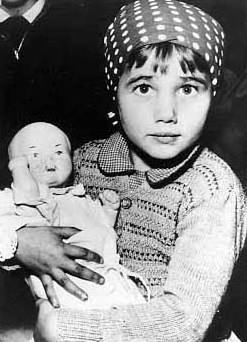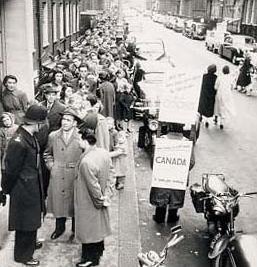The sponsorship system was one very popular method of circumventing the difficulties of the Immigration Act. Canadian residents sponsored thousands of dependent relatives, many of whom were destined for Toronto, Ontario. Toronto consistently received over 50 percent of all arriving immigrants. Certain ethnic groups were more likely to sponsor relatives than others. Over 90 percent of Italians were sponsored relatives, and Italians became the ethnic group with the highest overall rate of sponsored immigration. Among some native-born Canadians a concern arose over the large number of arriving semi-skilled immigrants who they feared would lower the working wage and create ghetto-like slums in Toronto, Montreal, and Vancouver. Until 1957 non-white, non-European immigrants composed only about 5 percent of immigrants.

Hungarian refugee child upon arrival in Canada circa 1957
The power of ministerial discretion at this time is demonstrated by the Liberal government's decision between 1956 and 1957 to admit over 37 000 Hungarian refugees, who were fleeing from a violent revolution in their homeland. Little selectivity was practised in the granting of entry visas as the usual medical restrictions were eased, and the Canadian government provided free transportation to refugees by air and by sea. The federal and provincial governments cooperated in making special arrangements to provide financial and medical assistance for these refugees. Canada's trend towards increasing urbanization and industrialization made the cities a popular destination. Hungarian refugees settled disproportionately in Canada's urban centres despite the government's attempts to disperse them across Canada. British Columbia, for example, received the entire forestry faculty of the University of Sopran, a group of more than 300.
Hungarians in British Columbia.
By Zoltán Simon
Churches and their congregations helped co-ordinate and settle the thousands of Hungarian refugees who came to Canada following the 1956 Revolution.
During the critical period of late 1956 to early 1957, some 250 thousand Hungarians fled their country. Most crowded into refugee camps in Austria. The Canadian people sympathized with them and admitted about 37 thousand Hungarian refugees to Canada. About seven thousand came to British Columbia, a much larger number than other areas were willing to adopt. The size of the Hungarian ethnic group in British Columbia more than doubled in 1957. At the Abbotsford Airport, the old army barracks were turned into a refugee camp. The most well known group among the Hungarian refugees was the professors and students of the Forest Engineering University from the city of Sopron, Hungary. The staff and students of this venerable two hundred year old university were adopted into the University of British Columbia as a special Faculty of Forestry. This was a unique undertaking. The professors resumed their teaching and research and the students their studies. Sopron graduates from UBC spread to every Canadian province except Prince Edward Island and about 90 are still practicing their profession in British Columbia.
The Hungarian community in British Columbia is active. The churches and the Cultural Society provide the anchor to many of the activities. In addition, the Scout movement continues to draw support, as do the various social and cultural groups. The Canadian Hungarian Housing Society of BC has built and operates a 54-unit home for the elderly in Vancouver.
Just as the foresters from Sopron, the Hungarian refugees of 1957 have rapidly and successfully integrated into Canadian society. While they continue to cultivate their national and ethnic heritage, they identify with Canada. They add color, feeling and depth to the Canadian mosaic; they remind us that freedom is precious, it must be nurtured and protected: it must not be taken for granted.
In 1970, the Hungarian organizations of British Columbia persuaded the cities and municipalities of Vancouver, North Vancouver and West Vancouver to declare October 23, the anniversary of the 1956 Revolution, as Hungarian Day. History is on the side of the angels - since last year, the same day has become a national holiday in Hungary too. The sacrifice of the thousands who gave their lives for freedom is acknowledged on a plaque in Vancouver's Queen Elizabeth Park (1989) and in Burnaby's Forest Lawn Memorial Park (1986).
